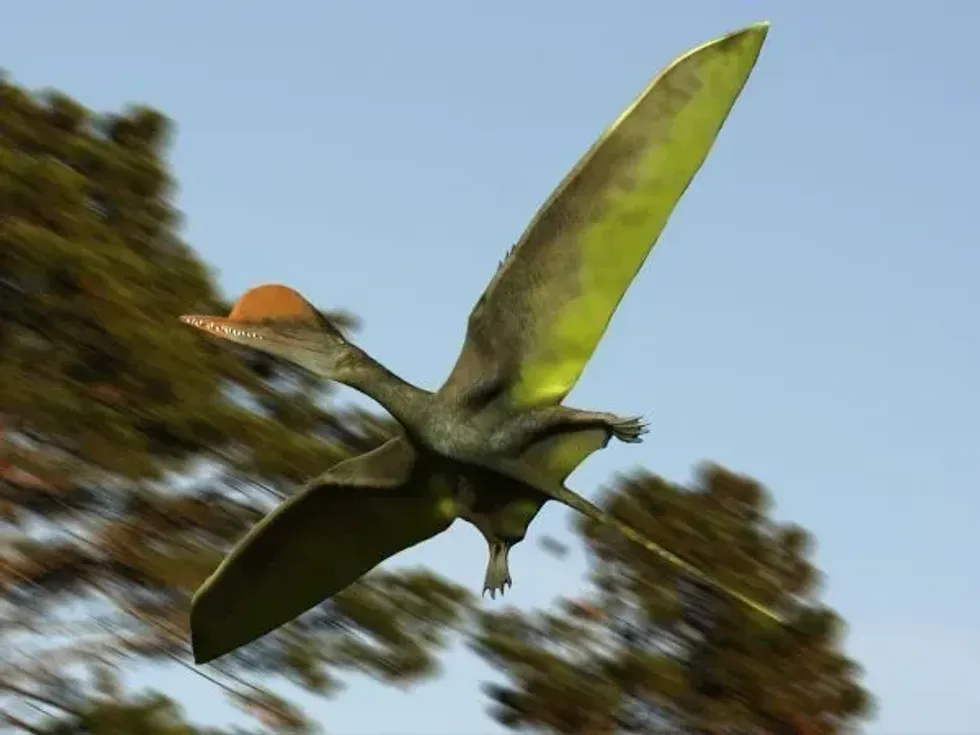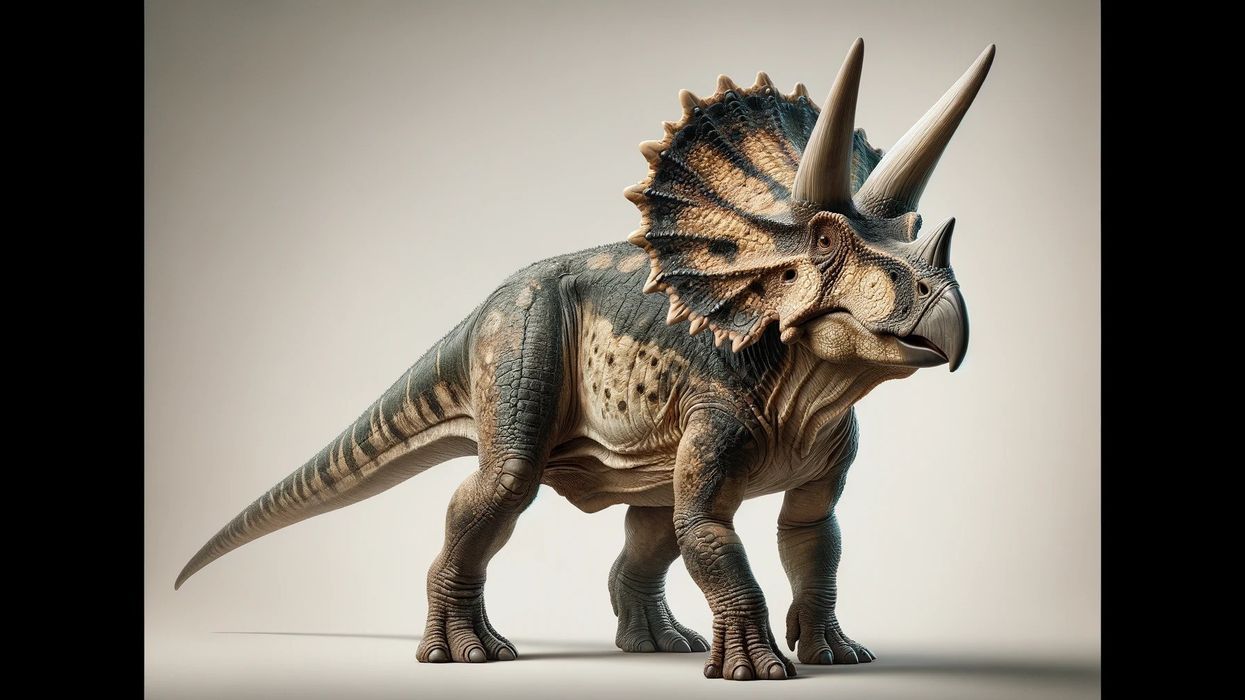Darwinopterus, also known as Darwinopterus modularis, used to inhabit the present-day China region, its fossil specimen was discovered in the Tiaojishan Formation. Its name means 'Darwin's wing' and the animals are called so in reference to Charles Darwin, the biologist.
No information is available about the habitat and environment of this genus.
It is known to have lived from the Bathonian to Oxfordian time of the Jurassic period and is commonly known to belong to the Middle Jurassic time.
Reproduction used to take place just like all the other reptiles, that is, sexually but from the found fossil specimen, it was recorded that the eggs of the Darwinopterus had a soft, parchment-like shell like those of later pterosaurs and unlike the hardened shell of eggs of modern birds.
This soft shell allowed the eggs to be permeable and water was absorbed during the development.
Their eggs were known to be buried in the soil. Their reproduction was known to be similar to that of modern reptiles and not birds.
Certain characteristics of these reptiles' physical appearance include long tails and these long tails were stiffened by thin, long bony projections. The Darwinopterus also had long neck vertebrae and one opening in front of the eyes.
The back part of the skull had a relatively greater length than the ilium (hip bone), and nasal bone, and not much cannot be determined about their wings.
The head crest in the males was supported by bony and thin extensions.
Based on certain features, this genus is divided into three distinct species, namely D. modularis, D. linglongtaensis, and D. robustodens. The diet of this pterosaur based on the discovered fossil was considered to be piscivore or carnivore, that is, the food consisted of flying insects and fishes.
The type species, D. modularis, was described in 2010 and was described as a fossil that was transitional between two groups as it showed characteristics of both short-tailed pterodactyloid and long-tailed rhamphorhynchoid. Darwinopterus length is known to be around 36 in (91 cm). It is noted to have evolved from the primitive rhamphorhynchoid through modular evolution.
It is very fascinating to learn about this evolved reptile and if you are interested, read about Tapejara and Tropeognathus, too.
Darwinopterus Interesting Facts
Was the Darwinopterus a dinosaur?
Darwinopterus were known to be pterosaurs and not dinosaurs, but they lived in the same time period as dinosaurs.
How do you pronounce 'Darwinopterus'?
The pronunciation of this pterosaur is 'Dar-win-op-teh-rus'.
What type of prehistoric flying bird was a Darwinopterus?
These animals were classified as pterosaurs.
In which geological period did the Darwinopterus live?
It is known to have lived in the Middle Jurassic time.
When did the Darwinopterus become Extinct?
The exact time of extinction of these pterosaurs is not known.
Where did the Darwinopterus live?
It is known to have inhabited present-day China.
What was a Darwinopterus's habitat?
No information is available about the habitat and environment of these pterosaurs.
Who did a Darwinopterus live with?
It is unknown if these pterosaurs lived in groups or alone.
How long did the Darwinopterus live?
The life span of these pterosaurs is not known.
How did they reproduce?
Reproduction of these pterodactyloids takes place just like other reptiles, that is, sexually, where the male deposits sperm inside the female body and the females lay eggs.
Based on the specimen found, it has been studied that the eggs of the Darwinopterus had a soft, parchment-like shell, like those of later pterosaurs and unlike the hardened shell of modern birds.
This soft shell allowed the egg to be permeable and water was absorbed during the development.
These eggs were buried in the soil and the young ones were known to fly right after hatching and required almost no parental care. The reproduction of Darwinopterus was similar to the modern reptiles and slightly different than the birds.
Darwinopterus Fun Facts
What did a Darwinopterus look like?

Based on the Darwinopterus skeletal, it has been recorded that it had a long tail and the tail was stiffened by thin, long bony projections. It also had long neck vertebrae and one skull opening in front of the eyes.
The back part of the skull had a relatively greater length than the nasal bone and ilium (hip bone). The teeth were widely spaced and at the jaw tips, were the longest teeth.
It had spike-like teeth and was set in tooth sockets that had raised margins. The bones of the hand were quite short. It is believed that based on the skull size and other appearance features, there have been three distinct species recognized.
The head crest found in males was supported by bony and thin extensions. It is closely related to wukongopterids and rhamphorhynchoids, and thus, similar features could be reported in their appearances based on evidence.
Not much cannot be determined about the wings based on the fossils. There might have been sexual dimorphism based on the specimen studied from the Zhejiang Museum of Natural History.
How many bones did a Darwinopterus have?
The number of bones that these pterosaurs had is not known.
How did they communicate?
Communication of these pterodactyloids took place through various kinds of sounds.
How big was the Darwinopterus?
The estimated size was around 36 in (91 cm) and the Darwinopterus's wingspan was 3.2 ft (1 m).
How fast could a Darwinopterus move?
The exact speed of these pterosaurs is unknown.
How much did a Darwinopterus weigh?
Their weight was evaluated to be around 0.2-0.5 lb (110-220 g).
What were the male and female names of the species?
Males and females of these pterosaurs do not have any sex-specific names.
What would you call a baby Darwinopterus?
A baby Darwinopterus is referred to as a hatchling.
What did they eat?
The diet of these pterosaurs is considered to be carnivorous or piscivorous and their food was thought to have included flying insects and fish.
How aggressive were they?
Not much is known about the aggressiveness of pterosaurs.
Did you know...
The 30-40 fossils and specimens that have been found of this pterosaur were all found in the Tiaojishan Formation.
The type species, that is, Darwinopterus modularis, was first described in February 2010.
It has been noted that Darwinopterus modularis is the first pterosaur known that showcased characteristics of both the short-tailed pterodactyloid and the long-tailed rhamphorhynchoid.
It was noted to have been described as a fossil that was transitional between two groups.
It is closely related to wukongopterids and rhamphorhynchoids.
Apart from Darwinopterus modularis, there have been two different species recognized, that is, Darwinopterus linglongtaensis and Darwinopterus robustodens. These two different species were known to have been described from the same fossil bed around December 2010 and June 2011.
Darwinopterus modularis was named by Lu Junchang and his colleagues, and it was characterized by long back and skull and spike-like teeth based on the research articles and papers.
Lu Junchang and his other team of scientists described Darwinopterus robustodens, a new display specimen found that had robust teeth which is one of its most important features.
Darwinopterus linglongtaensis was named by Wang Xiaolin and their colleagues. Its main features were a short and tall skull and teeth that were cone-shaped as stated by the research papers and articles.
Due to the number of well-preserved transitional fossils and specimens, it has been recorded and predicted that in this reptile species, sexual dimorphism existed based on evidence, that is, females used to have broader pelvis or crest but this theory has faced criticism.
The first specimen from which the sex could be possibly identified was kept in the collections of the Zhejiang Museum of Natural History.
The discovery of this pterosaur fossil is considered to be one of the greatest discoveries of pterosaurs.
It is believed that these dinosaurs could be seen both on trees and on the ground, just like modern songbirds.
It is believed that the female pterosaurs did not have crests whereas the males used crests for mating displays.
Why are they called Darwinopterus?
Darwinopterus means 'Darwin's wing' and is called so in reference to Charles Darwin, the biologist.
How many fossils were found of Darwinopterus?
It is been recorded that around 30-40 specimens have been found.
Here at Kidadl, we have carefully created lots of interesting family-friendly prehistoric animal facts for everyone to discover! Learn more about some other creatures from our Dimorphodon fun facts, or Nemicolopterus facts for kids.
You can even occupy yourself at home by coloring in one of our free printable Darwinopterus coloring pages.
Main image by Nobu Tamura.
Second image by Didier Descouens.










